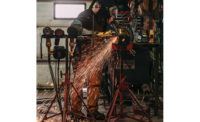A fall can occur in a split second without any time for the worker to react. But even when wearing the right fall protection equipment, a fall can still end in tragedy. Employers must train workers to recognize the signs and symptoms of orthostatic intolerance, also known as suspension trauma, and plan accordingly.
Quick response is key
Call 9-1-1 immediately upon knowing that a worker suffered a fall. Every second a worker remains hanging in suspension increases the risk of suspension trauma. Blood can begin to accumulate in the legs due to the pressure of the safety harness leg straps on the veins. After only five minutes, a suspended worker may begin to show symptoms such as light-headedness, heart palpitations, involuntary muscle contractions, poor concentration, fatigue, nausea, dizziness, headache, sweating, and weakness.
Any suspension lasting longer than thirty minutes may put the worker at an increased risk of suffering a serious or fatal injury, as the brain, kidneys, and other organs are deprived of oxygen and begin to shut down. Venous pooling and suspension trauma can be exacerbated by other factors that include:
- Inability to move the legs,
- Pain and injuries during the fall,
- Fatigue and dehydration,
- Hypothermia and shock,
- Cardiovascular and/or respiratory disease, and
- Blood loss.
Rescuers must recognize that moving a victim to a horizontal position too quickly could cause post-rescue death. Moving a worker too quickly to the ground could allow a large amount of used, deoxygenated blood to go to the heart, leading to cardiac arrest. Rescuers need to be knowledgeable of first aid techniques to avoid suspension trauma.
Training workers
Employers must train their workers to use fall arrest systems and other personal protective equipment (PPE) in accordance with 29 CFR 1910 Subpart I and 29 CFR 1926 Subpart M.
Workers that may be asked to perform rescue activities (including self-rescue) should be trained in:
- How to determine whether their PPE fits properly and will perform as intended;
- How suspension trauma may occur;
- How certain factors may increase a worker’s risk;
- How to recognize the signs and symptoms of suspension trauma; and
- How to implement rescue procedures to diminish risk while suspended.
Initiating a rescue plan
A rescue plan will provide guidelines for responding to falls from heights. Several standards require that employers provide for prompt rescue of employees in the event of a fall, including:
- 29 CFR 1910.140(c)(21) - The employer must provide for prompt rescue of each employee in the event of a fall.
- 29 CFR 1926.502(d)(20) - The employer must provide for prompt rescue of employees in the event of a fall or must assure that employees are able to rescue themselves.
- ANSI A92.22, Ch. 6.1.2.6.3 – The employer must have a rescue plan for employees working at height on a Mobile Elevating Work Platform.
- ANSI Z359.2, Ch. 8.3.1 - The employer must include rescue procedures as part of their fall protection program.
Some employers rely on their local fire department or emergency service provider as their sole fall rescue resource. While this can be an option, employers still need to plan and evaluate response times, accessibility, and rescue equipment available. A well thought out plan will describe how to perform rescue under specific locations or circumstances. The plan can address:
- Self-rescue,
- Assisted rescue, or
- Professional/technical rescue.
Self-rescue
When a worker who fell can climb to an adjacent structure or platform, this is a form of self-rescue. Other options may include using an automatic or user controlled descent system (e.g., self-rescue pack or rescue ladder) to allow the worker to control their own descent.
Often misunderstood, suspension trauma straps are not a form of self-rescue, but a means of delaying the negative effects of venous pooling in the legs while awaiting rescue. Pumping of the legs can also alleviate pressure, provide support, and delay symptoms.
Assisted rescue
When the worker must be rescued by others, the rescuer will use a controlled rescue/descent device allowing for fully automatic controlled descent. Another option includes a rescue pole of varying lengths designed to be used with a rope utility system. For low- and high-angle rescue, and the ability to lift horizontally or vertically, a rescuer may use a rescue stretcher or basket in a variety of applications. Also, a halfback extrication/lift harness can be used for quick extraction of a victim with upper body injuries requiring spinal immobilization.
Professional/technical rescue
When a worker is unable to self-rescue, and any trained in-house workers are unable to perform an assisted rescue, an outside agency (e.g., fire department) is summoned to perform the rescue. It is imperative the employer contact the outside agency in advance to perform a worksite review and understand the agency’s rescue capabilities.
Working at heights poses a risk to every industry. In 2021, the Bureau of Labor Statistics reported 825 fatal occupational injuries in the United States due to falls on the same or to a lower level. While an effectively used personal fall arrest system may initially prevent another devastating fatality, employers must develop a well thought out plan for how to rescue a worker after a fall. Rescue options should include self-rescue, assisted rescue, and professional (or technical) rescue from an outside source. Misunderstood and often overlooked, the rescue plan should also emphasize the dangers of and how to respond to suspension trauma.



